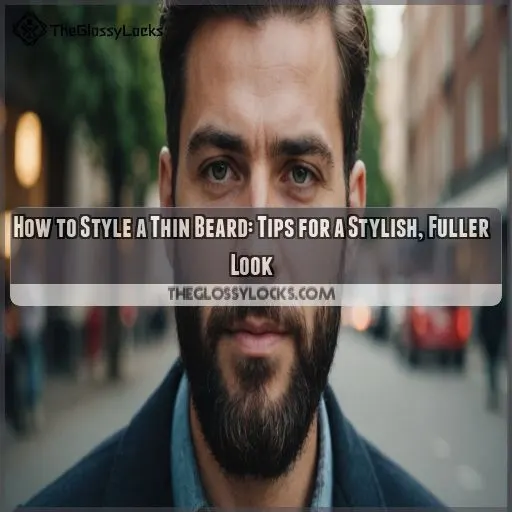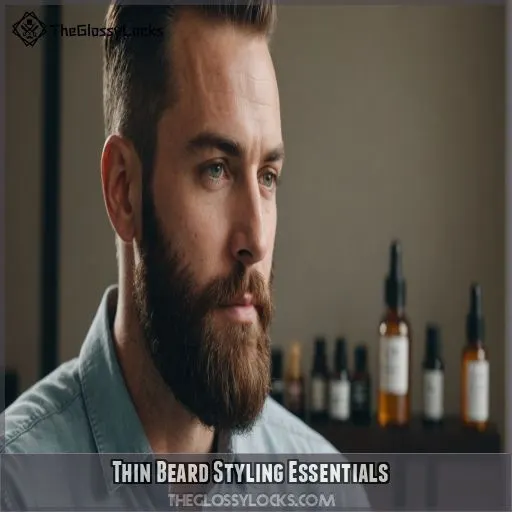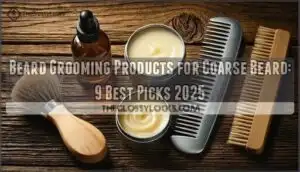This site is supported by our readers. We may earn a commission, at no cost to you, if you purchase through links.
 Styling a thin beard doesn’t have to be a struggle.
Styling a thin beard doesn’t have to be a struggle.
Start by choosing the right tools.
Look for a sharp, adjustable trimmer to keep your edges crisp.
Then, experiment with layering and texturizing techniques to add depth and dimension.
A little beard wax or pomade can tame flyaways and give you that polished look.
Don’t forget to exfoliate before shaving and use a nourishing beard oil to keep your thin strands healthy.
With the right grooming routine and a confident attitude, you can rock a stylish, fuller-looking thin beard.
Ready to take your facial hair game to the next level?
Keep reading for more expert tips.
Table Of Contents
- Key Takeaways
- Thin Beard Styling Essentials
- Beard Styles for Thin Hair
- Grooming Techniques for a Fuller Look
- Overcoming Common Mistakes
- Understanding the Root Causes of Thinning Beards
- How to Make Your Beard Hair Grow
- Embracing a Thin Beard
- Advanced Styling Techniques
- Frequently Asked Questions (FAQs)
- Conclusion
Key Takeaways
- Choose the right tools, like a sharp, adjustable trimmer, to keep your thin beard looking its best. Treat your beard like a masterpiece – trim it regularly to maintain the perfect shape.
- Embrace layering and texturizing techniques to add depth and dimension to your thin beard. Use beard wax or pomade to tame flyaways and achieve a polished, put-together look.
- Prioritize a healthy beard care routine. Exfoliate before shaving, use nourishing beard oil, and be patient – growing a fuller beard takes time, just like Rome wasn’t built in a day.
- Boost your beard’s thickness from the inside out. Eat a balanced diet, exercise regularly, and get enough sleep to support healthy facial hair growth. Your beard will thank you!
Thin Beard Styling Essentials
Styling a thin beard can be challenging, but with the right essentials, you can look like a grooming pro. From choosing the perfect trimmer to keeping your beard soft and healthy, you’ll be ready for anything—even if it’s just avoiding awkward chin-stares at your next Zoom meeting!
Choosing the Right Trimmer for Thin Beards
Choosing the right trimmer for your thin beard can be a game-changer. With precision in mind, here’s what you need:
- Trimmer blades: Look for sharp, adjustable ones.
- Cordless trimmers: Enjoy the freedom to trim anywhere.
- Maintenance tips: Clean those blades regularly.
- Beard oil: Keep that trim looking sharp and healthy.
- Trimmer brands: Opt for trusted ones.
Benefits of Using a Shavette for Thin Beards
Using a shavette for your thin beard? That’s like wielding a brush on a masterpiece. Its precision trimming helps craft clean lines, avoiding the horrors of razor burn and skin irritation. It’s perfect for beard styling and nurturing beard growth even in patchy areas. Check out the perks below:
| Benefit | Description | Result |
|---|---|---|
| Precision | Exact trimming | Clean lines |
| Flexibility | Maneuvers easily | Controlled cuts |
| Cost-effective | Blades are replaceable | Saves money |
Organic Shave Soap for a Healthy Beard
Using an organic shave soap is essential for maintaining a healthy, well-groomed thin beard. Look for soaps with nourishing ingredients like shea butter, coconut oil, and essential oils. These natural formulas gently cleanse, condition, and soften your facial hair, preventing dryness and irritation. Ditch the harsh drugstore soaps and embrace a more natural beard care routine.
Importance of Pre-shave Oil for Thin Beards
For guys with thin beards, using pre-shave oil is like prepping your car before a long drive. You wouldn’t risk it without a tune-up, right? Pre-shave oil softens your hair, reduces razor friction, and prevents those pesky bumps. Opt for oils like jojoba or almond. It’s the secret weapon your grooming routine deserves!
Aftershave for Soothing and Conditioning the Skin
Once you’ve prepped your skin, aftershave swoops in like your trusty sidekick, soothing and conditioning with healing properties. Choose alcohol-free alternatives to avoid skin irritation. Look for these ingredients:
- Aloe Vera: Natural, soothing magic.
- Chamomile: Calms irritated spots.
- Witch Hazel: Reduces redness.
It’s beard vitamins for your face! A smooth finish for your 5 o’clock shadow adventures.
Beard Styles for Thin Hair
Choosing the perfect beard style can transform a thin beard into a striking feature that complements your unique look. Don’t sweat the small stuff; embrace styles like the goatee or stubble, turning any day into a good beard day!
Goatee Styles for Thin Beards
If you’re rocking a thin beard, the classic goatee is a fantastic option. This versatile style frames your chin and can create the illusion of a fuller, thicker beard. Experiment with different goatee shapes – from the classic point to a rounded or tapered look. Pair it with a well-groomed mustache for a polished finish.
| Goatee Shape | Description | Ideal Face Shape |
|---|---|---|
| Classic Point | Narrow, pointed chin beard | Oval, Square |
| Rounded | Wider, rounded chin beard | Round, Heart |
| Tapered | Gradually narrowing chin beard | Oblong, Diamond |
| Anchor | Goatee with connected mustache | Strong Jawline |
| Van Dyke | Goatee with separate mustache | Oval, Square |
Chin Strap and Its Variations
Check out the chin strap: a classic callback to the Victorian era, offering clean-cut precision for a jawline that commands respect.
Keep it sharp with regular chin strap trimming and maintenance.
Don’t skip chin strap beard oil for added softness!
Experiment with chin strap variations, but steer clear of common mistakes men with thin beards make. Patience and a steady hand win.
5 O’Clock Shadow for a Rugged Look
Ready to rock a rugged style without going off the deep end? The 5 o’clock shadow is your ticket! No mess, no fuss—just bold, unshaven charisma. Remember these grooming tips:
- Understand face shape: Keep it proportional.
- Embrace stubble growth: Skip the daily shave.
- Master beard maintenance: Nourish and hydrate for peak “scruff appeal”.
Mustache Styles for Thin Beards
While the relaxed 5 o’Clock Shadow style is enticing, a well-groomed mustache can be your secret weapon for a thin beard. Embrace styles like the Chevron or natural mustache, offering a touch of elegance and charm. Keep it neat with regular trims and a dash of personality. Remember, a stylish mustache commands attention and speaks volumes—without uttering a word.
Stubble and Its Versatility
A stubble look can be a versatile choice for men with thin beards.
It provides a rugged, low-maintenance style that accentuates your facial features.
Whether you prefer a light dusting or a more defined stubble, this style can be easily adjusted to complement your face shape and personal style.
Embrace the freedom of a stubble beard and let your natural texture shine through.
Grooming Techniques for a Fuller Look
Transforming a thin beard into a fuller one can feel like training a houseplant to sing opera—funny but totally doable with the right techniques! You’ll need to master regular trimming, exfoliation, and a solid beard care routine, all while embracing patience like you’d a delayed pizza delivery.
Regular Trimming for a Thicker Beard
You’ve chosen your beard style, now let’s talk trimming.
Picture your beard like a growing masterpiece; you wouldn’t let a garden run wild, would you?
Regular trimming with the right tools controls split ends and maintains your ideal beard shape.
Embrace the beard growth cycle, and remember, trimming frequency is your ally.
Shape up, and let your beard do the talking!
Exfoliating Before Shaving for a Smoother Skin
Start your grooming routine by exfoliating before shaving, giving you a smooth sail to flawless skin. Grab your exfoliating tools and see the magic:
- Kick-start shedding dead skin cells with ease.
- Reveal radiant skin under that beard, like unearthing treasure.
- Enhance your pre-shave prep for a seamless shave.
Aim for this velvety canvas before you conquer the beard world!
Beard Care Routine for a Healthier Beard
Keeping your beard healthy is key to achieving a fuller, more stylish look.
Start by washing it regularly with a gentle beard wash to remove dirt and excess oil.
Follow up with a nourishing beard oil or balm to hydrate and condition the hair and skin.
Finish by brushing or combing through to distribute the product evenly and tame any stray hairs.
Importance of Patience and Consistency in Beard Growth
You’ve nailed your beard care routine, but don’t stop there! Growing a beard’s like baking a cake—you need patience and dedication. Don’t expect a lumberjack look overnight. Stick to your consistent routine, and trust the process. Your beard goals take time, much like Rome wasn’t built in a day, neither is a glorious beard!
Overcoming Common Mistakes
Styling a thin beard can be tricky, but avoiding common mistakes can make all the difference. Don’t let daily shaving and neglect turn your beard into a patchy disaster—embrace a good routine and watch it transform!
Avoiding Daily Shaving for a Thinner Beard
We get it: life’s a whirlwind, but don’t shave daily if you want a thicker beard.
Sure, it feels tidy, but you’re disrupting the beard growth cycle.
Embrace a bit of stubble and trim with care to boost hair follicle health.
Too much shaving can cause skin irritation, making you wish for smoother sailing!
Neglecting Beard Care and Its Consequences
Neglecting your beard care routine can have dire consequences. Beard breakouts, dryness and itch, split ends and breakage, beard dandruff, and even ingrown hairs can plague your thin beard if you don’t give it the attention it deserves. Stay on top of washing, conditioning, and trimming to keep your beard looking its best.
- Invest in a quality beard wash and conditioner
- Apply beard oil or balm daily to hydrate and nourish
- Trim regularly to prevent split ends and maintain shape
Keeping the Patch and Its Alternatives
Leaving the patch alone is like letting weeds take over your garden, but fear not! You’ve got choices.
| Solution | Pros | Cons |
|---|---|---|
| Beard Fillers | Quick fix | Needs daily application |
| Beard Transplant | Permanent solution | Costly and invasive |
| Camouflage Techniques | Effective cover-up | Time-consuming |
| Microblading | Natural look | Requires maintenance |
Explore these patchy beard solutions, and regain control!
Importance of Pre-shave Preparation
Leaving patches behind, let’s talk about setting the stage before the razor hits your face. Proper pre-shave prep is like gearing up for battle – without it, you risk razor burn and unhappy skin! Exfoliate to clear away dead skin, pick a good razor, and lather on quality shaving cream. Trust me, your skin will thank you!
Shave and Go: the Dangers of Improper Shaving
After proper prep, rushing to shave is like jamming a square peg into a round hole. You risk razor burn, ingrown hairs, or annoying skin irritation. Nicking your skin can leave you with blotchy patches that make you cringe. So, take your time. Your face will thank you, and you’ll walk away with a smooth canvas, not a battlefield.
Understanding the Root Causes of Thinning Beards
Struggling with a thin beard? Don’t worry, the root causes are often within your control. From genetics and age to hormones and lifestyle, understanding the factors behind your beard growth can help you take the right steps to achieve the fuller look you desire.
Genetics and Its Role in Beard Growth
When it comes to growing a beard, not everyone has the luck of Zeus-like thickness. Blame genetics herehair follicles inherit patterns that dictate beard thickness. Some folks have silky coverage while others have patchy paths. Ethnic differences add spice to the mix. So, embrace your unique beard; it’s like your personal facial fingerprint! Plus, it makes shaving more exciting.
Age and Its Effects on Beard Thickness
As you grow older, your beard might start getting thinner. It’s natural! Here’s how to navigate age-related beard changes:
- Accept the journey: Your beard evolves through stages.
- Stay active to combat testosterone decline.
- Focus on diet for maintaining thickness.
- Beard care over 50 requires patience and new grooming tricks. Embrace it like a well-aged wine!
Health Conditions and Medications Affecting Beard Growth
When your beard’s not behaving, blame those pesky health conditions or medications you might be dealing with. Hormonal disorders, thyroid issues, autoimmune diseases, and chemotherapy effects can all play havoc with your facial hair. Not to mention, some medications have side effects that make your beard a bit shy. Stay positive and consult with your doctor for solutions!
Hormonal Imbalances and Their Impact on Beard Growth
Hormonal imbalances can really impact your beard growth.
Low testosterone and DHT levels, thyroid issues, and chronic stress all contribute to thinning facial hair.
The good news? You can combat this by making simple lifestyle changes.
Managing stress, getting enough sleep, and maintaining a balanced diet rich in nutrients that support healthy testosterone production can all help.
Take charge of your hormones, and watch your beard flourish.
Poor Diet and Lifestyle Choices
Ever hear the saying, "You are what you eat"? Well, it often holds true for your beard too! Want a fuller, more stylish look? Focus on:
- Nutrition: Eat balanced meals.
- Stress: Find ways to relax.
- Sleep: Catch enough Z’s.
- Hydration: Drink plenty of water.
How to Make Your Beard Hair Grow
If you’re aiming for a healthier, fuller beard, you’ll need a toolbox packed with proper nutrition, exercise, and rest. Think of these as your beard’s personal trainers and dieticians, helping each strand grow to its full potential while you’re counting sheep.
Diet and Nutrition for a Healthier Beard
Sure, genetics play a role, but when you’re trying to boost beard growth, think of your plate as a treasure map.
Load up on vitamins, minerals, and protein like you’re a pirate hunting for gold.
Fruits, veggies, nuts, and whole grains are the gems here.
Consider supplements for the extra oomph.
Your beard’s destiny is in your hands—or on your fork!
Exercise and Its Role in Beard Growth
Regular exercise, particularly strength training, can be a game-changer for growing a thicker beard. By boosting your testosterone levels, you’ll see an increase in facial hair growth. Plus, the improved blood flow from your workouts delivers essential nutrients to your hair follicles, promoting healthier, fuller beard development. Get ready to level up your beard game!
- Incorporate strength training into your routine
- Focus on compound exercises like squats and deadlifts
- Aim for at least 3 strength sessions per week
- Be patient – it can take several weeks to see results
Blood Circulation and Its Effects on Hair Growth
You’ve lifted weights and now want to boost hair growth? Improve blood flow to your hair follicles—more blood means more nutrients. Try a scalp massage; it’s like giving your beard a VIP treatment. Some folks swear by hair growth supplements, but remember, no magic pills. Make exercise a beard-buddy, keeping those exercise benefits coming, strong and healthy!
Reducing Stress for a Healthier Beard
When you’re stressed, toss it aside like an old hat. It’s not doing your beard any favors! Mindfulness and stress management can boost beard growth.
- Try mindfulness to calm your mind.
- Meditation works wonders.
- Exercise regularly to shake off tension.
- Embrace relaxation techniques like deep breathing.
- Laugh often—it’s nature’s stress buster!
Getting Enough Sleep for Beard Growth
Hit the sack early and you’ll see your beard growth take off! Quality sleep boosts hormone levels, really important for thickening that chin carpet. Aim for 7-9 hours to recharge those beard-growing engines. Think of sleep as your secret weapon; it silently works its magic while you dream. Neglecting sleep? Well, that’s like trimming potential from your face.
Embracing a Thin Beard
Embracing a Thin Beard
Don’t let a thin beard get you down – with the right styling and grooming techniques, you can rock a stylish, fuller-looking beard. Confidence is key, so find a beard style that flatters your face shape and own it with pride.
Confidence and Self-Acceptance
Stepping into your own skin starts with self-love and embracing imperfections. A thin beard? It’s not a flaw, it’s character! You’re like a Picasso—unique and vibrant. With a positive mindset, redefine body image by focusing on inner beauty. Wear your confidence like a crown, and soon, others will see the masterpiece you’ve always been.
Finding the Right Beard Style for Your Face Shape
When choosing a beard style, your face shape is your secret weapon. Got a strong jawline? Rock a chin strap! Short chin? Keep the hair length minimal. Your hair type dictates style too; embrace the uniqueness. Remember, it’s not about hiding but highlighting! Figure out what works and, as they say, the world’s your oyster!
Grooming and Maintenance for a Thin Beard
Keeping a thin beard in check can feel like wrestling an octopus, but it doesn’t have to be. Follow these steps for success:
- Use a quality beard wash regularly.
- Apply beard oil daily to nourish.
- Style with beard balm for control.
- Comb or brush for even distribution.
Master these, and you’ll own that thin beard with confidence!
Seeking Professional Advice
If you’re struggling to embrace your thin beard, don’t be afraid to seek professional help. A skilled barber can provide personalized recommendations on beard growth treatments, styling techniques, and the right products to enhance your look. They’ll work with you to find a flattering style that boosts your confidence. Don’t go it alone – let the experts guide you.
Advanced Styling Techniques
Crafting a thicker-looking beard isn’t as hard as spotting a unicorn, but it does require a few clever tricks up your sleeve. With layering, texturizing, and the right styling products, you’ll transform your thin beard into a masterpiece that even Zeus would envy.
Layering and Texturizing for a Thicker Beard
Think of your beard as a masterpiece in the making. Layering techniques let you create depth, while texturizing tools work like an artist’s brush. Engage in beard trimming with precision—don’t just mow the lawn, sculpt it! Integrate these into your beard care routine, and bam! You’re not just wearing a beard; you’re owning it.
Using Beard Wax and Pomade for Styling
Just like layering adds depth, beard wax and pomade are secret weapons for styling thin beards. Think of wax as your beard’s best friend, taming flyaways with military precision. Meanwhile, pomade adds texture like slicked-back hair on a ’50s greaser. Whether you’re waxing or pomading, a dab here and a rub there, and you’re golden!
Creating a Defined Edge for a Neater Look
Achieving a defined edge for your thin beard is key to a polished, neat look. Invest in a quality shavette or straight razor to precisely trim the perimeter. Apply a touch of beard balm to smooth flyaways and keep your edges crisp. Take your time and use short, careful strokes for a clean, sharp beard line.
Styling a Thin Beard for a Formal Event
When prepping your thin beard for a formal event, focus on clean lines and strategic shaping. Picture your beard as an elegant tuxedo for your face—precise and polished. Use thin beard products for shine and control, ensuring every hair behaves. Event-specific grooming might include a touch of beard wax. Remember, a sharp outline screams class and confidence!
Experimenting With Different Beard Styles
In the ever-changing world of facial hair trends, finding the perfect beard shape is like hunting for buried treasure. Get style inspiration by mixing shapes; try a Van Dyke today, a Goatee tomorrow. Adapt beard length to suit your vibe—short for authority, longer for freedom. With some clever grooming tips, you’ll wield styling power like a pro!
Frequently Asked Questions (FAQs)
How can I make my thin beard appear thicker?
To make your thin beard appear thicker, focus on a balanced diet, regular exercise, and proper grooming. Embrace styles like the goatee or anchor. Remember, patience is key—your beard’s a marathon, not a sprint!
Are there specific tools for thin beard grooming?
Did you know 60% of men feel more confident with the right beard tools? Use a shavette for precise trims, organic shave soap to soften, and pre-shave oil to protect—it’s like giving your beard a spa day!
What are natural remedies to enhance beard growth?
To naturally boost your beard growth, try massaging your face with a few drops of castor oil or peppermint oil daily. These oils stimulate blood flow and nourish hair follicles for thicker, fuller facial hair. Just don’t overdo it – a little goes a long way!
How does diet impact the thickness of a beard?
Feeding your ambition for a fuller beard involves painting your plate with protein-rich foods and a kaleidoscope of fruits and vegetables. Nourishing your body’s engine sets the stage for the majestic growth you dream of.
Can stress contribute to thinning beard hair?
Absolutely, stress can send your beard on a mini-vacation! When life’s pressures rise, your body might lower testosterone and blood flow, leading to thinner growth. Manage stress, and keep your beard thriving with mindful relaxation.
Conclusion
They say, "Rome wasn’t built in a day," and the same goes for achieving the perfect beard.
Embrace the journey with well-chosen tools and a personalized routine, and you’ll soon master how to style a thin beard.
So, experiment, stay patient, and wear your beard with pride.
You’re just a few snips and strokes away from greatness.




